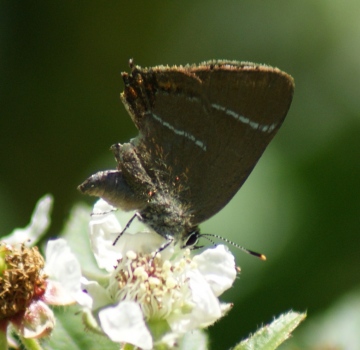Species Account for Satyrium w-album
Satyrium w-album (Knoch, 1782)
White-letter Hairstreak
Lepidoptera: butterflies: Lycaenidae

Reproduction for study and non-profit use permitted, all other rights reserved.
Taxonomic group: butterflies (Lepidoptera: butterflies) - County data
View time series maps for Satyrium w-album
member log-on for taxon report
W&C Act: Schedule 5
Status: EN;Legal Protection;Section 41 Priority Species
Essex RDB: Listed
Images
upload a new image
White-letter Hairstreak on UK Butterflies website
Essex Red Data List comment
Added to list due to 'Endangered' national conservation status (2010 review, Butterfly Conservation)
Species text
The White-letter Hairstreak Strymonidia w-album is a widely but locally distributed butterfly of southern and central England, Yorkshire and Wales. The larva feed on elms in sheltered hedgerows, mixed scrub, and along the edges of woodland rides, as well as on large isolated elms, with colonies usually confined to a small group or even a single tree. Although the butterfly seems to have become rare in the 1970s with the loss of elms to Dutch Elm Disease, it has been recovering, the larvae using sucker regrowth (Asher et al., 2001). One of the best sites in Essex is Hadleigh Downs where adults readily feed at low level on bramble blossom throughout the flight season. This can occur on other sites particularly during very dry periods (e.g. 2010) or in the middle of hot days when sap/honeydew is not available. Generally however, adults are seen flitting high amongst elm suckers or adjacent ash branches. References
Habitats
Recorded management for locations with Satyrium w-album
Recorded substrate and hydrology for locations with Satyrium w-album
Why not join the Club, register and add a new species page
Interpretation of distribution maps



















